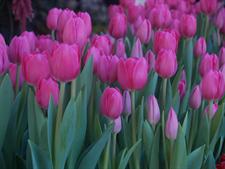Cut Flower Grower
Types of crops produced by a flower grower include:
- Annual flower crops (e.g. carnations, sunflowers, poppies, stock, statice)
- Bulbs (e.g. tulips, daffodils, gladioli, iris) - can sell both the bulbs and the flowers
- Woody perennial plants (e.g. roses, proteas, heathers). Tropical or greenhouse plants (e.g. orchids, gingers, heliconias)

Ways of Growing Cut Flowers include:
- Row crops in open paddocks
- Greenhouse Crops
- Hydroponic Crops
- In garden settings. Gardens created with beds of cut flower producing plants may have a dual purpose (e.g. a large rose garden may attract visitors who pay to enter the garden, buy food at a café, and the flowers may then be harvested and sold as cut flowers through a flower market).
- Some market gardeners may grow hedges that also produce a cut flower crop e.g. Proteas
What They Do
 Outdoor cultivation: Routine tasks may include cultivating paddocks, planting, weeding, watering, spraying pests, harvesting flowers, lifting and dividing bulbs, post-harvest handling (e.g. packing, applying chemicals to lengthen the flowers lifespan), and shipping.
Outdoor cultivation: Routine tasks may include cultivating paddocks, planting, weeding, watering, spraying pests, harvesting flowers, lifting and dividing bulbs, post-harvest handling (e.g. packing, applying chemicals to lengthen the flowers lifespan), and shipping.Indoor cultivation: flowers grown in a greenhouse or in hydroponics can be a relatively high-tech operation, requiring
a high level of scientific knowledge and hands on technical skills. Some flower farms use very sophisticated equipment to control light, temperature and humidity conditions in order to manipulate flowering times. Both potted and in ground plants can be grown this way.
What is Needed
A cut flower grower needs general horticultural skills and knowledge - but also an ability to grow a healthy, unblemished flower that is durable after harvest. They need to know how to harvest it correctly and how to package and treat the harvested product.
The cut flower farmer using hydroponics or greenhouse growing needs to be a very good business manager and employ highly skilled technical staff, if the farm is to return an appropriate profit for the investment made.
Opportunities
Cut flowers are always in demand, especially if you can produce a flower that transports well, has good shelf-life and is different to what is widely available. Demand exists all year round for weddings, funerals etc. but peaks at certain times e.g. Mothers' Day, St. Valentine's Day etc. Although some flowers are seasonal growers do manipulate flowers to grow out of season creating a continuance of supply. Niche markets are opportunities for growers who can offer something different and not add to the oversupply of popular species e.g. roses.
MORE ADVICE
Use our FREE COURSE & CAREERS ADVISORY SERVICE (click)
More from ACS
Ebook - 117 pages of wonderful information, stunning pictures and great facts on lavenders.
View eBook
Ebook - Over 60,000 copies sold: a classic reference.
View eBook
Ebook - Colourful informative book: covers all aspects of growing and using these lovely plants.
View eBook
Ebook - Identify, select, grow, care, propagate, landscape,
dictionary of perennials.
View eBook
Ebook - colourful guide for students, home gardeners and orchid enthusiasts. Covers care and identification.
View eBook
Ebook - colourful guide for the enthusiast or commercial grower alike.
View eBook
Become a Professional horticulturist studying 2 years full time; 4 years p/t
View Course
Very comprehensive - great starting point to your career in horticulture.
View Course